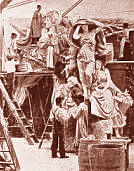

![]()
![]()
This Page:
Laure Coutan-Montorgueil
Maria Dillon
Fraulein Finzelberg
Frances M. Goodwin
Mary R. Grant
Harriet Hosmer
Vinnie Ream Hoxie
Mme. Clovis Hugues
Jeanne Itasse-Broquet
Adelaide Johnson
Edmonia Lewis
![]()
![]()
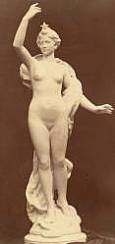
Sirius
--
representative work.

La Fortune
--
representative work.

Monument to André Gill--
representative work.

Spring
--exhibited
in the Woman's Building,
1893 Exhibition.
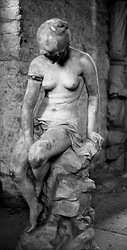
The Source
--exhibited
in the Rotunda, Woman's
Building, 1893 Exposition.
French sculptor Laure Coutan-Montorgueil was born at Dun-sur-Auron, Cher and studied under Alfred Boucher. Her work includes monument sculptures and busts of public people like the astronomer Leverrier, Prince Napoleon, General Boulanger, and the Countess de Choiseul.
![]()
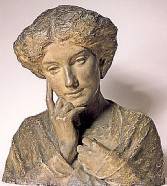
Dreams
1909--
representative work.

Tenderness
1891
--representative work.
Bliss and Caprice (image unavailable)--
exhibited in Fine Arts Palace, 1893 Exposition.
Maria Dillon was the first Russian woman to become a professional sculptor. Born in St. Petersburg, she studied art at the Imperial Academy of Fine Arts at St. Petersburg. Among those who purchased her work were Emperor Nicholas II, the grand duke Alexis, and the grand duke Serge.
![]()

[Title unknown]--representative work.

Ihr Kinderlein kommet, Oh 'kommet nach all,'
zur Krippe herkommet."
--representative work.
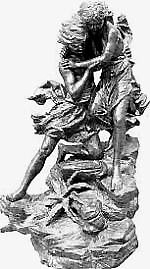
Brother
and Sister--
exhibited in the
Woman's Building,
1893 Exposition.

Europa
--
representative work.
Bedouin
Wife and Child and Paul and Virginie (images unavailable)--
exhibited in Rotunda, Woman's Building,
1893 Exposition.
Lilli Finzelberg Wislecenus was the daughter of a prominent chemist in Berlin, but lived in Duesseldorf with her uncle, the painter Hermann Wislicenus. Lilli studied at the Technical University in Charlottenburg and married her cousin, the painter Hans Wislecenus in 1896. She would have been only 21 years old at the time of the Chicago World's Fair.
![]()

Vice President Schuyler Colfax
--representative work
Education was exhibited in the Indiana State Building,
1893 Exposition. See image of
Goodwin statuary.
Frances M. Goodwin was born in Indiana and educated at the Indiana Art School (briefly) and the Art Institute of Chicago. She worked for Larado Taft at the 1893 Exposition where she received her first commission--a statue of "Education" for the Indiana State Building, followed by studies with the famous sculptor Daniel French Chester at the Art Students' League in New York and then four years in Europe. Her statue of Schuyler Colfax resides in the Senate Gallery of the U.S. Capitol. She was also selected to create the monument for the women's right activist Robert Dale Owen, but the bust was subsequently stolen.
![]()

Saint Margaret and the Dragon
1881--representative work

Charles
Stewart Parnell 1892--
representative work.

Henry Erskine,
1746-1817. Lord
Advocate (1877)--
representative work.
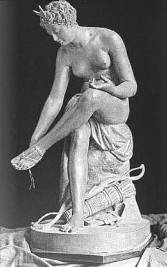
Diana--exhibited in Woman's
Building, 1893 Exposition.
Mary Grant was the daughter of a Scottish laird. She studied first in Paris under Fantachiotti, in Florence under Merier, then in London under J. H. Foley. Using her family connections (her artist-uncle Sir Francis Grant was President of the British Royal Academy, for instance), Grant managed to obtain many commissions to create busts of important figures like Queen Victoria and Charles Stewart Parnell. She often exhibited at the British Royal Academy.
![]()
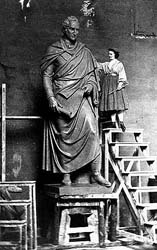
Hosmer on stepladder next to her Senator
Hart (dressed in a classical toga) sculpture.
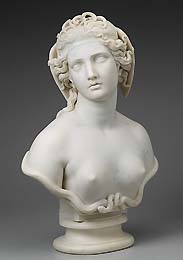
Medusa--
representative work.

Daphne--
representative work.
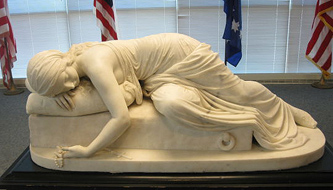
Beatrice Cenci--representative work.

Puck on a Toadstool--
representative work.

Will-o-Wisp--
representative work.


Sleeping Faun--
representative
work.

Zenobia,
Queen of Palmyra, in Chains--
representative work.

Queen Isabella 1893--LARGE IMAGE HERE.
Exhibited in
the California Building, 1893 Exposition.
Click here to see Queen Isabella on display (at
end of the hall) in the Palace of
Fine Arts at the 1894
California Midwinter International Exposition. [The
Queen is handing over her jewels to finance
Columbus' voyage.]
Harriet Hosmer was probably the most well-known and successful American woman sculptor of the nineteenth century. Born in Watertown, Massachusetts, she began her studies in Boston with Stevenson and with her physician-father who taught her anatomy. In 1852, she went to study in Rome where she remained for most of her adult life as the leader of a group of American women artists expatriates. Hawthorne immortalized her as Hilda in his Italian novel The Marble Faun, and Robert and Elizabeth Barrett Browning became her good friends. Her neo-classical statue of Queen Isabella of Spain was commissioned for the 1893 World Fair by a group of activist women, known as the Chicago Isabellas, who believed the Queen (who financed Columbus's trips to the New World) deserved as much recognition as did Columbus whose "discovery" of America was being honored at the Fair. The Isabellas also wanted their own building. More conservative members of the Board of Lady Managers of the Woman's Building objected, but then the sculptor objected to her statue being shown in a sex-segregated "woman's building." Quite a controversy broke out, making fund-raising for the sculpter's fees difficult to accomplish. There were also arguments about where Hosmer's statue should be shown, some of the authorities feeling Hosmer's neo-classical style was too old-fashioned and "heavy." The plaster version of the Queen Isabella statue ended up belatedly being shown in the California Building, but not enough funds were ever raised to have it cast in the more permanent bronze medium. The plaster version was sent the following year to San Francisco for display at the 1894 Mid-Winter Exposition where it aroused further controversy over the "Jewish question," the Queen being accused of mistreatment of Jews in Spain. Finally, the statue disappeared; no one seems to know how, where, or when. For more information on the Queen Isabella statue, consult one of the following:
Kate Culkin. Harriet Hosmer: A Cultural Biography. (U of Massachusetts 2010), pp. 136-60.
Lauren A. Maxwell. "Constructions of Femininity: Women and the World's Columbian Exposition". (2009). Undergraduate Honors Thesis Collection. Paper 40.
Mae Silver. "1894 Mid-Winter Fair: Women Artists, an Appreciation". Found SF (March 17, 1994).
Jeanne Madeline Weimann. The Fair Women: The Story of the Woman's Building, World's Columbian Exposition, Chicago 1893. (Chicago, 1981).
![]()
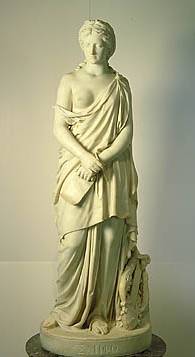
Sappho--
representative work.

Abraham Lincoln
--
representative work.

The West
1893--
exhibited in Rotunda
Woman's Building,
1893 Exposition.

America
1893--
exhibited in Rotunda,
Woman's Building,
1893 Exposition.
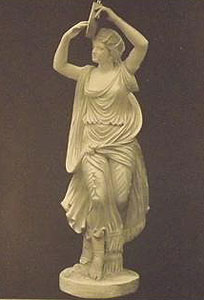
Miriam's Song of Triumph--exhibited in the
Rotunda, Woman's Building, 1893 Exposition.
Born in a frontier town in Wisconsin, the largely self-taught sculptor Vinnie Ream Hoxie was the talk of Washington, D.C. when, at age 19, she became the first woman and youngest artist to ever receive a commission from the United Stated Government for a statue. That statue of Abraham Lincoln stands today in the U. S. Capitol Rotunda. She also received other major government commissions for statues of American heroes and male dignitaries, but at the 1893 World Fair, her female statues (shown above) resembled more the beauty and dignity of her Sappho statue which resides today on her tombstone.
Biography/5 images--find out why else she was the talk of the town.
Artworks by Vinnie Ream--9 images
Vinnie Ream Hoxie at Iowa and Elsewhere--more on her career and social life
Lincoln--image
![]()
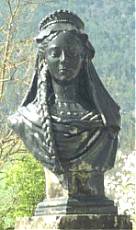
Le Comtesse
de Die
--representative
work.
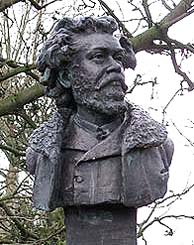
Clovis
Hugues 1893--
representative work.
My Little Lass (image unavailable)--exhibited
in the Woman's Building, 1893 World's
Exposition.
Born Jeanne Royannez in Paris (the daughter of Royannez Adolphe), the adult sculptor evidently used only the name of her socialist-journalist husband, calling herself Mme. Clovis Hugues. She was trained by sculptor Laure Coutan, but was probably better known to much of the general public for the scandalous situation that led to her husband dueling with and killing a man who had insulted her (her husband was acquitted). No more information is available online.
![]()
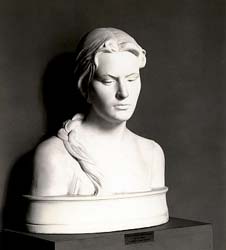
Anna Vaughn Hyatt
Huntington
c.1895--representative work
[Image courtesy of Huntington Museum].
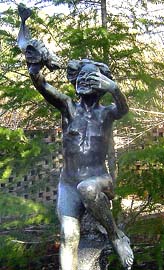
Girl with
Fish Laughing--
representative work.
[Image courtesy
of Huntington Museum].

Anna Vaughn
Hyatt Huntington--
representative work [Image
courtesy of Huntington Museum].
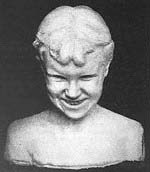
Laughing
Girl--
exhibited in the
Fine Arts Palace,
1893 Exposition.
Harriet R. Hyatt was born in Massachusetts to Audella Beebe Hyatt and paleontologist Alpheus Hyatt II. Her first art lessons were from her mother, an amateur painter. She was briefly enrolled at the Cowles Art School in Boston and was trained by sculptors Henry H. Kitson and Dennis Bunker and by watercolorist Ross Turner, all of Boston. Her sister Anna V. Hyatt Huntington was also a well-known sculptor and the two shared a studio in Cambridge for a number of years. Harriet married Alfred G. Mayor, a zoologist whose father was a noted physicist. Harriet's specialties were portraits and memorial plaques.
![]()
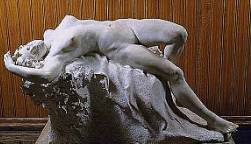
Bacchante--representative work.

Mademoiselle Marie
Salle,
"la Terpsichore française"
1887--exhibited in the
Rotunda, Woman's
Building, 1893 Exposition.
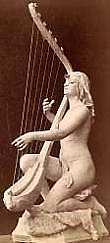
Egyptian
Harpist
1891--exhibited in
Fine Arts Palace,
1893 Exposition.
Head of an Old Woman (image unavailable)--
exhibited at the Fine Arts Palace, 1893
Exposition.
Jeanne Itasse was born in Paris and studied with her sculptor-father Adolph Itasse. She began exhibiting at age fourteen, winning many prizes over the years, including a medal at the Chicago Exposition 1893. Her bust of the danseuse Marie Salles was purchased by the Government for the Opera, and her "Egyptian Harpist" won her the "travelling purse" for 1891 and an invitation from the Viceroy of Egypt. Her married name was Broquet.
![]()
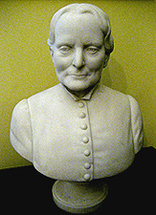
Bust of Dr. Caroline Brown Winslow 1892--
exhibited in the Rotunda, Woman's Building,
1893 Exposition.

The Portrait Monument--[left to right]
Elizabeth Cady Stanton, Susan B. Anthony, Lucretia Mott.
Created in 1892 and exhibited as individual bust portraits
in the Rotunda, Woman's Building,
1893 Exposition.
Three of the images were used in this group monument
to woman's suffrage that was created in 1920 and is now
exhibited in the U. S.
Capitol Building.
Born on a farm in Illinois, Adelaide Johnson became known as the "sculptor of the women's movement." She studied in the St. Louis School of Design, but desiring to become a sculptor, she traveled to Rome to study under Monteverde and Altini. She made busts of suffragists Susan B. Anthony, Lucretia Mott, and Elizabeth Cady Stanton, all of which (along with a bust of Dr. Caroline B. Winslow, a pioneer physician) were on display at the 1893 World Fair. A decade later, Johnson secured a national commission to create for the United States Capitol building a sculpture called "The Women's Movement" or the "Portrait Monument" (its current name). Financed by the National Woman's Party, this seven-ton marble statue contained copies of the earlier busts of Anthony, Mott, and Stanton. Dedicated in 1921 on Susan B. Anthony's birthday, it is the only national monument to the women's movement.
Letter from Susan B. Anthony--comments on the suffragist busts and Johnson's unusual wedding.
![]()
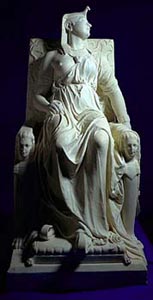
The Death of Cleopatra (1876)--exhibited
at the 1876 Philadelphia Centennial Exposition.

Veiled Bride
of Spring
allegory 1879
--representative work.
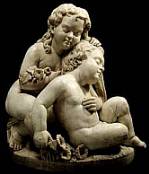
Night (Two Sleeping
Children)
allegory--
representative work.

Rebekkah at the Well--
representative work.
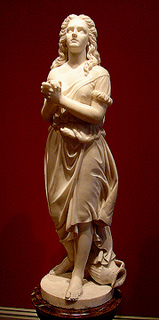
Hagar in the
Wilderness
1875--representative work.
Columbus --
representative work.
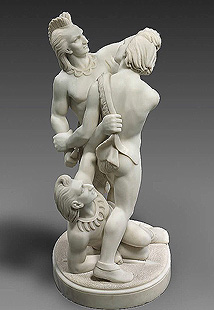
Three Indians
in Combat 1866--
representative work.
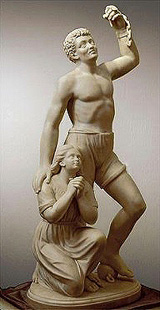
Forever Free
1867--
representative work.

James Peck Thomas 1874
--exhibited in Woman's
Building, 1893 Exposition
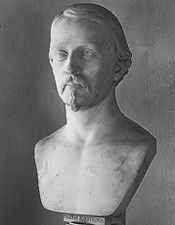
Colonel Robert Gould Shaw
(abolitionist hero)--
representative work.
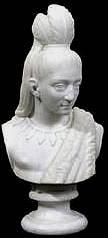
Hiawatha
(1868)--
exhibited in Woman's
Building, 1893 Exposition.
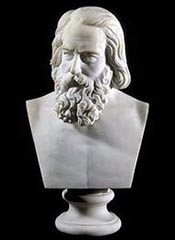
Henry Wadsworth
Longfellow--
author of "Song of Hiawatha."
Phillis Wheatley and Charles Sumner (images
unavailable)--
exhibited in Woman's Building, 1893 Exposition
The impressive twelve-foot sculpture The Death of Cleopatra by Edmonia Lewis was on display in Chicago in 1892, but not at the Woman's Building or anywhere in the "White City" at the 1893 World Fair. Instead, it was on the wrong side of town--in a saloon--and then lost soon after. A sculptor of mixed heritage (her father was a free Haitian-American, her mother part-black/part Objiwe), Lewis was born in Greenbush, New York and orphaned by her early pre-teens. Assisted by an older half-brother who went west and achieved some success in investments, Edmonia attended New York Central College and Oberlin College, both known for their abolitionist leanings, and later studied sculpture in Boston under Edward Augustus Brackett and perhaps with Anne Whitney. Her earlier statues tended to be abolitionist and Civil War heroes like John Brown, Robert Gould Shaw (the white commander of the first all-black Union regiment of the Civil War), Frederick Douglass, and Abraham Lincoln, but she eventually moved to Italy to escape the race consciousness and discrimination too common in the U.S. As part of a thriving art colony of American women in Italy which included established sculptors like Harriet Hosmer, Anne Whitney, and Emily Stebbins, Edmonia developed considerable recognition for her neoclassical style exemplified by her Cleopatra statue which was a big hit at the 1876 Centennial Exposition in Philadelphia; however, by the 1890s, the neoclassical style was becoming old-fashioned and her remarkable statue was sold, presumably to meet storage costs, and was not recovered until nearly 100 years later. It now resides at the Smithsonian Art Museum. She also made religious statues ("The Magi," "Virgin Mary," "Hagar," "Rebekah"), and sculptures depicting Native American subjects, such as her "Hiawatha" sculptures based on Henry Wadsworth Longfellow's well-known poem "Song of Hiawatha." The James Peck Thomas (b. 1827) shown in the image above was a slave whose freedom was purchased by his mother; he made a fortune in real estate in St. Louis and could readily afford to commission Lewis to make a statue of himself.
The Object at Hand--loss and restoration of Cleopatra
![]()
![]()
Go to International Women Sculptors, p. 3
Return to International Women Sculptors, p. 1
Return to Site Index
![]()
![]()
Text written by K. L. Nichols
Photograph, top of page: Larado Taft and his "White Rabbits"
(primarily Julie Bracken) preparing "The Battle of the Flowers"
statuary for the Agricultural Building entryway.
Return to Nichols Home Page
Suggestions/Comments: knichols11@cox.net
Posted: 6-25-02; Updated: 1-20-17